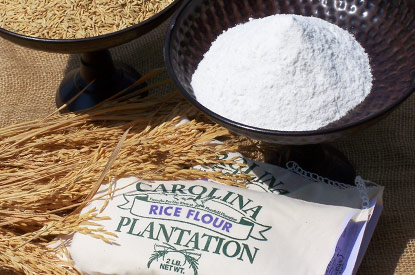
As reported in Southern Living, "All You Need to Know About Rice: Rice has been a staple in our dishes and our culture for generations. Here's the story--and the recipes that bring it home," by Donna Florio, published in 2013.
Standing waist deep in a 60-acre sea of rice, Robert Petter, Jr., of Stuttgart, Arkansas, marvels at the high-tech tools his family uses to cultivate the land they have owned for a century. Years of driving an unair-conditioned thresher in the blazing heat and laying out miles of levees by hand have given him an appreciation of the comparative ease with which they operate today.

"We're ‘robo-farmers' these days," he says with a smile. "We're in the fields with cell phones, pagers, GPS, and shop-door openers." The Petters now use lasers to design the levees that control the level of the water in the ricefields, which they harvest in comfort from the air-conditioned cab of a $160,000 combine.
Robert and his brother, David, work alongside their father, Robert, Sr., who has been farming rice, wheat, and soybeans all his life on the land farmed by his father.The brothers both have college degrees in other areas but chose to return to the family business. The Petter spread is one of roughly 4,200 Arkansas farms that together produce nearly half the U.S. rice harvest of 458 million bushels.

The Arkansas industry is not without its problems though. "The average age of farmers in this area is mid-60s," Robert says. "Most of the ones I know seem to farm until they fall over dead." Water is an equally serious issue--the shallow groundwater that provides 9 of every 10 gallons that flood the fields is being depleted. A federally funded reservoir system is under way, but it will take 10 years to determine whether it will control enough water to keep the rice farms operating.

The Carolina Connection
Water was not a problem in the South Carolina Lowcountry, where rice was first grown in this country in the late 17th century. A ship's captain traveling from Madagascar reputedly gave a Charleston planter seeds that flourished in the swampy soil. Local farmers quickly realized that abundant water and slave labor made the Lowcountry an ideal location for producing huge amounts of the grain.
Using picks and shovels, slaves built the levees and dikes that formed 150,000 acres of ricefields--a project likened to building the pyramids. They also cultivated the rice, a harsh and dangerous job. The planters grew incredibly wealthy from these labors, exporting Carolina Gold rice to Europe. They used their wealth to build a refined society and most of the beautiful homes in Charleston. When slavery was abolished, the South Carolina rice industry all but disappeared, moving to states where land was better suited to machine harvesting. In Bluffton, South Carolina, though, Dick Schulze, an ophthalmic surgeon, has been growing Carolina Gold as a hobby for nearly 20 years.

"When I bought Turnbridge Plantation 30 years ago, there were some functioning ricefields," he explains. "I grew some rice mostly to attract ducks. Then I began to read about Carolina Gold and found some seeds at Texas A&M's seed bank. The folks there generously grew a crop and sent us 14 pounds," Dick says. "We planted all of it and harvested it by hand, which was quite a job. Within a few years, we had a few thousand pounds." His son, Richard, Jr., later located and painstakingly restored an old rice milling machine. The Schulzes donate their harvest to a Lowcountry church, which sells it as a fund-raiser.

A New Tradtion on the Great Pee Dee
Near Darlington, South Carolina, Campbell Coxe feels a similar connection to the rich history of the Carolina rice culture. "Georgetown produced more rice than anywhere else in South Carolina," he says, "and we're on the Pee Dee, so we irrigate out of one of the same rivers the early planters did." He explains that back then, the tide pushed fresh water up the river back into the ricefields. Today, Campbell uses a diesel pump to water the aromatic rice that he and wife Meredith market under the name Carolina Plantation Rice. Although the variety is Della, a long-grain aromatic rice, the soil, water, and latitude of the Coxe's fields produce an exceptional grain with a nutty, popcorn-like aroma.
Wherever it is grown, rice is one of the South's most sustaining and versatile grains. It is an admirable complement to any entrée that includes gravy or sauce, and it can be used as a base for pudding or patties. Its sturdiness and absorption qualities allow it to join with meats, vegetables, and broths in main dishes.

Which Rice? Here are some helpful definitions of the most common varieties of rice.
Some cooks suggest washing the grains before cooking for a fluffier finished product, but we found the washed rice to be stickier than the batch that we didn't wash. (source: Southern Living)
- Long-grain rice has long, slender kernels that cook up separate, light, and fluffy.
- Medium-grain rice is slightly shorter and wider than long-grain. Cooked kernels are moist, tender, and slightly sticky.
- Short-grain rice kernels are almost round and stick together when cooked. It has a higher starch content than other rice.
- Brown rice has the outer hull removed, but retains the bran layers that give it a tan color, chewy texture, and nutlike flavor. Brown rice has more minerals, vitamins, and fiber than white rice.
- Parboiled rice is soaked, steamed, and dried to remove the outer hull. Grains are firmer and more separate and retain more nutrients than regular rice.
[http://www.common-place.org/vol-11/no-03/roberts/]
0 comments:
Post a Comment